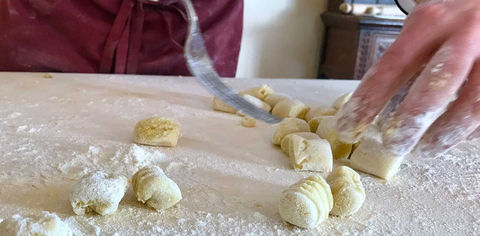
Ah, Italy. The mere sound of the word is enough to make you daydream of la dolce vita. There’s an irresistible pull from all corners of the country, from the colourful villages cascading down cliffs to the undulating green hills dotted with vineyards to the sparkling beaches blessed with golden sand and secluded coves for swimming. Among the nation’s many alluring attributes — charming architecture, beautiful art, fascinating history — is its food, which has drawn visitors in droves, and even inspired countless cookbooks and songs. Every bite feels like a sacred moment. By Alisha Prakash
And one of the best things about Italy’s cuisine is that it’s not too difficult to bring a taste of the Boot to your own kitchen. For proof, we turned to 18 Italian hotel chefs to share their favourite recipes. Recreate these dishes at home now, then try them firsthand on your next trip to Italy.
Here are some of the favourite recipes of hotel chefs from Italy
Tuscan bread and tomato soup
Luigi Incrocci, Executive Chef of Il Giardino Restaurant at Sina Villa Medici in Florence

“This bread and tomato soup are one of the most traditional Tuscan dishes. It has peasant origins and very simple ingredients. Today, it’s no longer considered ‘poor man’s food’ and doctors and dieticians recommend it as a healthy dish.”
Ingredients
Serves: 4 people
- 1 kg ripe tomatoes
- 350 gr Tuscan bread, sliced
- 20 leaves basil, chopped into thin julienne strips
- 150 gr Tropea onions, chopped
- Extra virgin olive oil
- Salt and pepper, to taste
- Vegetable broth, as required
Instructions
Wash the tomatoes and plunge them into boiling water for a few seconds.
Remove the skins and put them through a food processor.
In a saucepan, heat three tablespoons of extra virgin olive oil and the chopped Tropea onions.
Add the broth and let it simmer until the onion is soft. (The broth can be dosed by eye, depending on how much is desired.)
Add the tomatoes and raise the heat.
Cook for five minutes to allow the sauce to thicken slightly. Add the salt and pepper to taste.
Add the thinly sliced bread and chopped basil into thin julienne strips.
Lower the heat and mix well, making sure the soup does not stick to the bottom of the pan.
Keep adding hot broth, stirring regularly for 30 to 40 minutes or until the soup has a nice, smooth consistency.
Tortellini in Brodo di Cappone (Tortellini in Chicken Stock)
Silvia Grossi, Chef at Il Salviatino in Florence

“I was born in Modena, and my childhood was full of traditional dishes from my region — lasagne, tortellini, maccheroni al ragu, tagliatelle, zampone, cotechino — too much, too good. But my favourite recipe is tortellini in brodo di cappone. I started learning how to make tortellini when I was just five years old with my grandmother. I had to climb on the kitchen counter and tried and tried to make the shape of the tortellini. I remember being very happy when, after trying several times, I could get somewhat close to what the tortellini should look like. I was so proud to put my tortellini close to the perfect ones made by my grandmother. Now I know how to do them, and on Christmas day, when my family is all together, the tortellini is never missing from our table — handmade, one by one, like a long time ago.”
Ingredients
For the Tortellini
- 7 oz (198 gm) white flour
- 2 whole eggs
- Pinch of salt
For the Tortellini Filling
- 5 oz (141.7 gm) minced pork meat
- 3 tbsp. Parmigiano-Reggiano cheese
- 1 tbsp. breadcrumbs, toasted
- 2 oz (56.6 gm) mortadella, finely minced
- 2 oz (56.6 gm) Parma ham, finely minced
- 1 egg yolk
- Salt, pepper, and nutmeg
For the Capon (or Chicken Stock)
- 1 capon (or whole chicken), about 2 lbs.
- 3.5 oz (99.2 gm) celery, chopped
- 3.5 oz (99.2 gm) carrots, chopped
- 2 white onions cut in half
- Water, salt, and bay leaves
Instructions
Mix all the tortellini ingredients together to form a dough. Cover and put the mixture in the fridge for two hours.
Cook the minced pork in a pan with olive oil, salt, and pepper. Let it cool in a colander to eliminate the liquid that will form. In a bowl, mix with the rest of the filling ingredients.
Cut the chicken into four large pieces. In a big pot, add all the ingredients together and boil slowly for four to five hours.
Remove the pasta dough from the refrigerator. Stretch the dough until it’s fine and cut it into one-by-one-inch squares.
Put some filling in the centre. Fold into a triangle, being careful to seal the edges well, then turn the first corner until you catch the other. Push to close.
When the tortellini and stock are ready, boil them for three to four minutes.
Add just a sprinkle of parmesan cheese.
Tuscan Gnocchi
Alessandro Manfredini, Chef at Renaissance Tuscany Il Ciocco Resort & Spa in Lucca

“Growing up in Barga with my family, the gnocchi was one of those classic recipes that brought all of us together. It’s one of the first dishes I learned to make as a child. Simply put, to me, a plate of gnocchi feels like home.”
Ingredients
- 2 lbs (907 gm) potatoes
- 1 egg
- 10 oz (283.4 gm) flour
- Salt, to taste
Instructions
In a large pot, boil potatoes (skin on) with just enough water to cover them. Boil for about 20 minutes, or until fork-tender.
Once cooked and cool enough to handle, peel the potatoes and mash them. Mix in the egg and salt, followed by the flour. Mix until you reach a dough-like consistency.
Shape small portions of the dough into long “snakes.” On a floured surface, cut the dough into cubed pieces. Use a fork to gently imprint lines. (This helps the gnocchi hold more sauce.)
Gently shake away any excess flour and place gnocchi in a large pot of salted, boiling water. Cook gnocchi until they float to the top, about two to four minutes. Gently remove the gnocchi with a slotted spoon; drain very well.
Toss them in a saucepan with your favourite Italian sauce and cook together for about two minutes. Buon appetito!
Zucchini Blossoms Stuffed With Ricotta, Taleggio, and Black Olives
Fabio Ciervo, Executive Chef of Il Giardino Ristorante at Hotel Eden in Rome

“Ingredients are key, especially the freshness of the flowers. It’s a simple and light recipe with a very delicate flavour. In addition, zucchini flowers are only available in the spring, and this is the perfect season to enjoy the simplest things, at home,” says one of the 18 Italian hotel chefs, Fabio Ciervo.
Ingredients
Serves: 4 people
- 16 zucchini blossoms
- 280 g. ricotta
- 25 g. black olives
- 80 g. Pachino cherry tomatoes, chopped
- Extra virgin olive oil
- 100 g. taleggio cheese, diced
- Pinch of dried oregano
- Chervil, for garnish
Instructions
Preheat the oven to 140 degrees (60 degrees celsius). Place the ricotta cheese in the oven for about one hour to make it a bit drier.
Mix the ricotta and taleggio cheese in a bowl using a wooden spoon. Add some salt and pepper and mix it with about 15 grams of black thinly chopped olives. (Taggiasche olives from the Liguria region, which are small and sweet, are recommended.)
Wash the zucchini blossoms and dry them carefully. Fill the piping with the cheese mixture and partially stuff the blossoms. Fold them up to create a small pocket shape.
Place the zucchini blossoms in a Pyrex dish and put it in the heated oven for a couple of minutes in order to warm up the ricotta cheese and let the blossoms gently cook.
Cook the half-chopped Pachino tomatoes in a pan with a little olive oil, salt, pepper, and dried oregano on high heat. Add the remaining black-stoned olives and let them cook for a few seconds.
Place the zucchini blossoms in a fan-shaped arrangement on the plate, and add the cooked tomatoes and olives in the middle. Garnish the dish with some chervil leaves and zucchini blossoms julienne. Drizzle a little bit of olive oil on top.
Mare e Monti (or sea and mountains)
Andrea Antonini, executive chef of Imago at Hotel Hassler in Rome

“Mare e Monti, meaning sea and mountains, is a typical Italian dish. As the name suggests, the flavours of this dish are a combination of ingredients from the mountains (such as mushrooms) as well as the sea (such as prawns). It’s a quick recipe. I created my own take on this traditional Italian recipe, which is typically a pasta dish, without any carbs. I replaced the pasta with mushrooms. The dish still looks like it’s served with pasta, but the base is actually made from mushrooms.”
Ingredients
Serves: 4 people
- 400 gr. cardoncelli mushrooms
- 300 g. gobbetti shrimp
- 100 g. butter
- Parsley, to taste
- Porto wine, to taste
- Brandy, to taste
- Paprika, to taste
- Pepper, to taste
- Oregano, to taste
- Lemon, to taste
- 1 spoon of lemon juice
- 1 lemon peel
- Seasonal herbs
Instructions
For the aromatic butter blend the butter, parsley, Porto wine, brandy, paprika, pepper, oregano, and lemon in a stand mixer.
For the bisque, toast 250 gr. of mushrooms with the prawns’ shells and heads. Simmer with brandy. Add ice and let it simmer for three hours. Filter and reduce.
Cut 150 gr. of mushrooms into julienne strips.
Clean the prawns, then sear them in a pan.
Put julienne mushrooms in a pan with water, just enough to soften them.
Add the bisque. Add the aromatic butter. Finish with a spoon of lemon juice and a lemon peel.
Serve on a soup plate, then add the prawns on top. Garnish with herbs.
Linguine alla Puttanesca
Matteo Temperini, Executive Chef at Rosewood Castiglion del Bosco in Tuscany
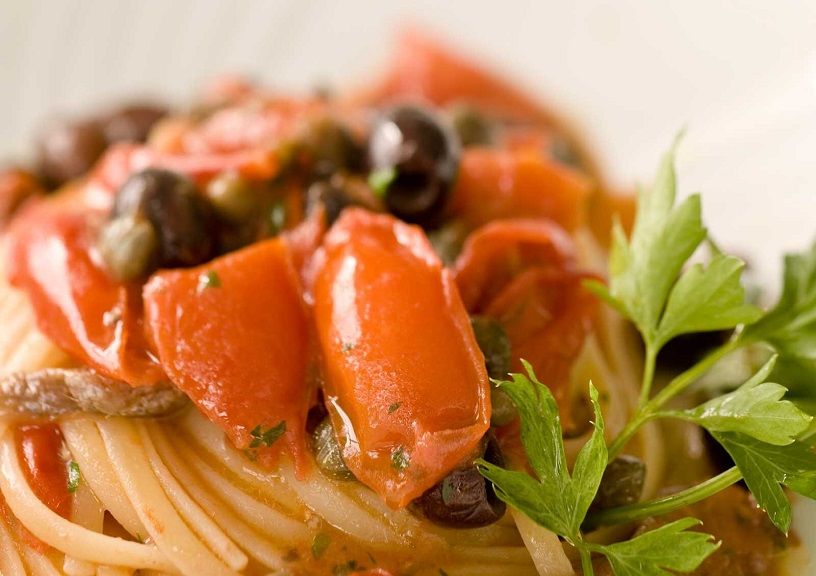
“I love this simple and traditional Italian dish. Growing up, my mother prepared this for me often in the summer, and it reminds me of my childhood and those beautiful, cheerful summer days. Today, I cook it for my son, hoping he will remember it when he is older the way I do.”
Ingredients
Serves: 4 people
- 400 gr. linguine pasta
- 1 garlic wedge
- 2 anchovy fillets
- 20 gr. capers
- 50 gr. parsley, minced
- 400 gr. cherry tomatoes
- 40 gr. extra virgin olive oil
- Chilli pepper, to taste
- Salt, to taste
- 20 gr. olives (taggiasche olives recommended, but not necessary)
Instructions
Brown the garlic, anchovies, capers, and chilli pepper with olive oil in a pan.
Add sliced cherry tomatoes and cook for two to three minutes. In the meantime, cook the pasta al dente in salted water. Drain well and pan fry it in the creamy sauce.
Add the parsley and olives. Serve.
Pasta with Zucchini and Prawns
Salvatore Bucceri, Chef at Hotel Villa Carlotta in Taormina
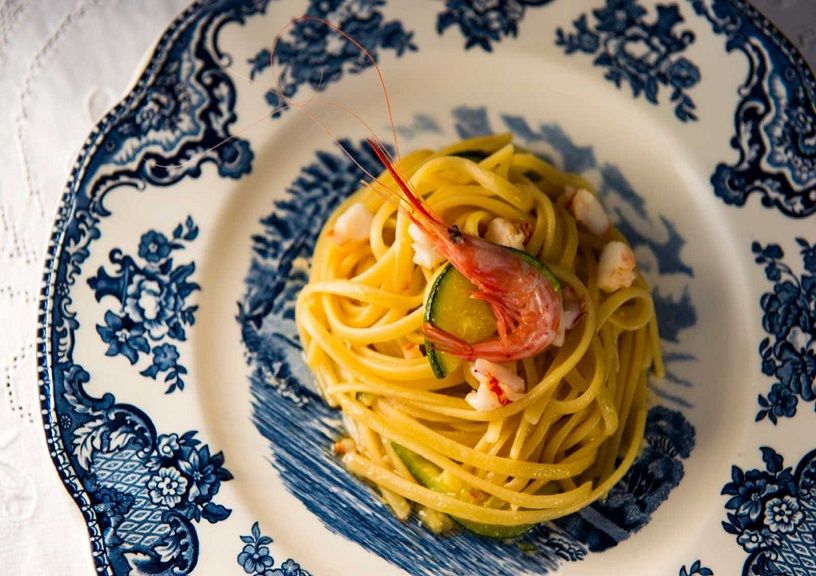
“This spaghetti with zucchini and prawns is a tasty and elegant Italian seafood pasta recipe. It’s simple and takes no time at all to prepare. Zucchini is a great summer vegetable — Italians use this vegetable (which is actually botanically a fruit) in soup, frittatas, fritters, and pasta, like this one. This dish is light and summery — it doesn’t have a lot of sauce. However, the ingredients meld together to coat the pasta with lots of flavours. You can also eat it cold as a pasta salad. I added some peperoncino to give the dish a bit of a kick, but if you don’t like your food spicy, you can leave it out.”
Ingredients
- 400 g. (14 oz.) spaghetti or other pasta tubes, like penne or paccheri
- 400 g. (14 oz.) prawns or shrimp (this recipe uses frozen prawn tails)
- 3 or 4 zucchini
- 2 garlic cloves, peeled and chopped
- 1 tbsp. capers
- 2 or 3 tbsp. extra virgin olive oil
- ½ glass white wine
- ½ tsp. peperoncino flakes (or 1 tsp. fresh peperoncino, chopped)
- Salt and pepper, to taste
- 1 handful of fresh parsley (optional)
Instructions
Clean and peel two-thirds of the prawns, removing the heads if they are whole. Keep one-third whole.
Wash the zucchini, remove the ends, and slice them finely with the help of a knife or mandolin. Cut the slices in half.
In a large frying pan or iron skillet, heat two to three tablespoons of extra virgin olive oil with the chopped garlic and peperoncino for a minute.
Add the prawns and capers to the pan, and cook for five minutes, until the prawns change colour. Add the white wine and let the alcohol evaporate. Add the zucchini and ½ cup of water. Add salt and pepper to taste.
Cover with a lid and simmer until the zucchinis are cooked (about 10 minutes). Stir with a wooden spoon from time to time.
In the meantime, boil water for the pasta. Add salt once it starts to boil and bring to the boil again. Cook the pasta until al dente.
Drain the pasta and add it to the pan with the zucchini and prawns. Stir everything together and serve immediately with some extra peperoncino or chopped parsley, if desired.
Saffron Risotto With Golden Leaf
Osvaldo Presazzi, Executive Chef of Grand Hotel Tremezzo in Lake Como
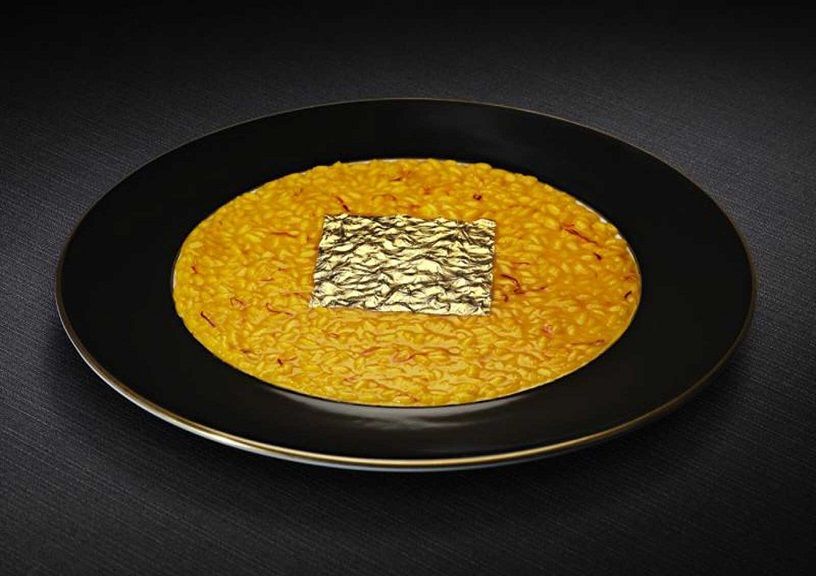
“This is the signature dish of Gualtiero Marchesi, the ‘Father of Italian cuisine.'”
Ingredients
Serves: 4 people
- 320 gr. Carnaroli rice
- 20 gr. grated Parmesan
- 100 gr. butter
- ½ gr. saffron in pistil
- 1 ltr. meat broth
- 1 glass of white wine
- Salt
Instructions
Soak the saffron in a glass of hot broth, enough that it is fully immersed.
In a saucepan, fry 20 g. of butter. Add the chopped onion and cook for a few minutes. Blend with the white wine to cool and filter through a colander, removing the onion.
Prepare the buttercream with the acid liquid and 60 g. of softened butter at room temperature.
In another saucepan, toast the Carnaroli rice with the remaining 20 g. of butter for a couple of minutes. Add in the white wine and let it evaporate.
Pour the broth to cook the risotto every time it dries. Halfway through cooking, add the saffron stigmas. Once cooked, keep the risotto on the wave (soft), so not too dry.
Spaghetti Carbonara
Martin Vitaloni, Executive Chef at Grand Hotel Victoria in Menaggio
“I created the dish on Lake Como. I wanted to give the carbonara sauce a new texture — a particular lightness — but without betraying the flavour, so I used the siphon to obtain this result. The idea came to me when I was in the gym — I don’t know why. I was happy that all the customers from all over the world appreciated it: Italians because it was unusual and not traditional; foreigners because the taste was original, but the shape unconventional.”
Ingredients
- 100 gr. spaghetti di Gragnano
- 25 gr. butter
- 20 gr. pecorino cheese
- 5 gr. black pepper
- 30 gr. guanciale
For the Carbonara Sauce
- 300 gr. egg yolk
- 80 gr. milk cream
- 20 gr. guanciale (bacon) fat
Instructions
Chop the guanciale and brown it in a pan until it is crisp. Set it aside and keep the fat.
For the carbonara sauce, simply add the egg yolks to the cream, and add the bacon fat. Adjust the salt and put the mixture in the siphon, loading it with the whipped cream cartridge. Keep the siphon warm, ideally at 65 degrees Celsius.
Cook the pasta in boiling, salted water until al dente. Sauté it in a pan with butter and pecorino cheese. Add the pepper and take care not to form lumps.
Plate the pasta and finish it with the siphon of carbonara sauce and the bacon crumble.
Ricotta and spinach Fiorentina gnocchi with tomato sauce
Daniele Sera, Executive Chef of Tosca at Belmond Castello di Casole in Tuscany

One of the popular Italian hotel chefs, Sera shares his recipe for his childhood favourite, gnudo di ricotta Alla Fiorentina (ricotta and spinach Fiorentina gnocchi with tomato sauce), which his Florentine mother prepared weekly for family gatherings.
Ingredients
Serves: 4 people
- 1 cup spinach
- 1 ½ cups ricotta cheese
- 1 shallot, finely chopped
- ¼ cup flour
- 3 egg yolks
- 1/8 cup parmesan cheese
- ¾ cup of red tomatoes, peeled and finely cut
- 1 yellow onion, chopped
- Basil leaves
- 2 garlic cloves, chopped
- 6 tbsp. butter
- Extra virgin olive oil
- Nutmeg powder, to taste
- Salt and pepper, to taste
Instructions
Finely chop up onion and garlic and brown in a saucepan with extra virgin olive oil.
Add in the tomatoes, previously peeled and finely cut; add the basil and cook for 40 minutes.
Finely chop the shallot and lightly brown in a pan with oil. Add the spinach, which you will have previously boiled, cooled down in water and ice, squeezed, and finely chopped with a knife.
Turn off the stove. Add the ricotta cheese, which you will have previously dried up in the oven at 110 degrees for one and a half hours. Add the egg yolks, flour, and parmesan, and season with nutmeg, salt, and pepper. Mix.
Prepare small gnocchi balls with the mixture.
Fill a saucepan with water, add salt, and bring to a boil. Cook the gnocchi for three minutes, drain and place them in a pan with melted butter.
To serve, place the tomato sauce gently on the plate and add the gnocchi.
Tubetti pasta with garden vegetables, Sicilian Pecorino, and Raspberry powder
Roberto Toro, Chef at Belmond Grand Hotel Timeo in Sicily

One of the popular Italian hotel chefs, Roberto Toro shares his personal interpretation of the traditional Sicilian dish of tubettini alle verdure e pecorino, which can be easily recreated at home.
Ingredients
Serves: 4 people
- 1 1/3 tubetti pasta
- ¼ cup onion
- 1/8 cup celery
- 1/8 cup carrot
- 1/8 cup asparagus
- 2 tsp. chicory
- 3 tsp. fresh broad beans
- 4 zucchini blossoms
- 1 tsp. wild fennel
- ¼ cup grated Sicilian pecorino cheese
- 2/3 cups raspberries
Instructions
For the vegetable stock
Roast celery, carrots, and onions in a pot with a drizzle of extra virgin olive oil. Add eight cups of water.
Cook on slow heat for approximately one and a half hours. Strain and keep it warm.
For the raspberry powder
Place the raspberries on a baking sheet with baking paper. Bake at 100 degrees (37.77 degrees Celsius) for 24 hours until dehydrated. Blend and strain.
For the Plate
Clean the asparagus and chicory, then cut the first into rounds and the second into small strips.
Wash and shell the broad beans, clean the zucchini blossoms and remove the pistil, and wash and mince the wild fennel.
Mince 10 gr. of onion and roast in a pan with a drizzle of extra virgin olive oil. Add the pasta and cook as if it were risotto for nine minutes, adding the vegetable stock a bit at a time. Halfway through the nine minutes, add the cleaned and cut vegetables and keep cooking.
Turn off the heat, and cream everything with the grated Sicilian pecorino cheese. Season with salt and pepper. Place the pasta on a plate and sprinkle with the raspberry powder.
Ligurian pesto sauce with Trofie pasta
Corrado Corti, Chef of La Terrazza at Belmond Hotel Splendido in Portofino
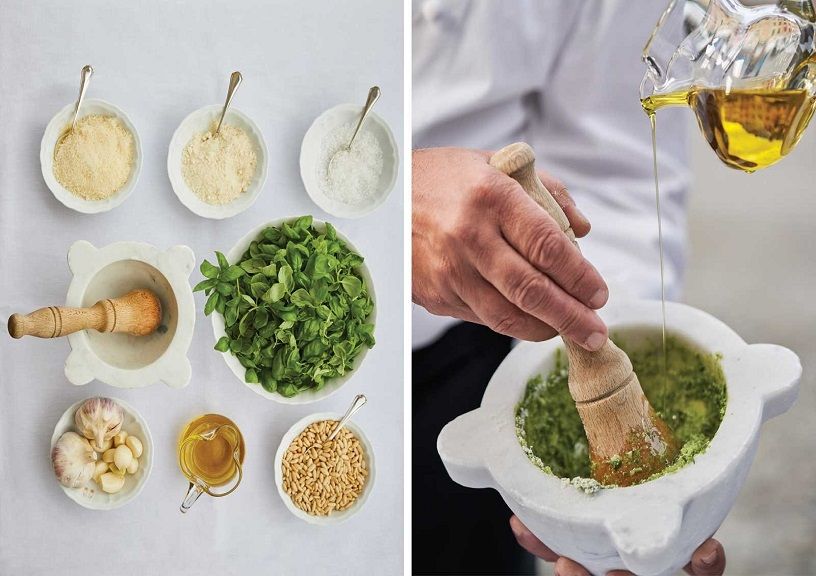
Chef Corti is devoted to Ligurian traditions, including linguine with his fresh pesto sauce. While he focuses on only using fresh, local ingredients, chef Corti shared the below recipe to recreate the dish at home.
Ingredients
- 1 ¼ cup basil leaves
- ¾ cup pine nuts
- ½ tsp. garlic
- 3/5 cup extra virgin olive oil
- Pinch of sea salt flakes
- ½ cup parmesan cheese
- ¼ cup pecorino cheese
- Trofie pasta
Instructions
Use a mortar to grind the garlic (without the heart), sea salt flakes, pine nuts, and basil (before adding, remove the stems, wash, and dry well).
Mix all with pecorino cheese, parmesan cheese, and extra virgin olive oil in a food processor.
Bring water to a boil and cook the pasta. Drain well.
Toss the cooked pasta with the mixture and serve with additional parmesan cheese on top.
Chicken with bell peppers
Michele Ferrara, Chef at J.K. Place Roma in Rome

“The recipe revisits a dish I am really fond of: chicken with bell peppers. It is historically considered a ‘poor dish’ yet it is extremely rich in flavours.”
Ingredients
Serves: 4 people
For the Chicken
- 2 organic chickens (250 gr. or 8.8 oz. each)
For the Side
- 1 red pepper
- 8 fresh spring onions
For the Basil Oil Preparation
- 200 gr. (or 7 oz.) fresh basil
- Extra virgin olive oil (500 ml.)
For the Butter and Rosemary Sauce
- 2 kg. (or 7.5 oz.) chicken bones
- 3 carrots
- 3 golden onions
- 2 garlic cloves
- 1 bunch rosemary
- 3 stalks celery
- 10 gr. (or 0.35 oz.) butter
- 25 cl. Balsamic vinegar
- 10 ml. soy sauce
For the Olive Powder
- 50 gr. (1.7 oz.) olives
Instructions
Butter and Rosemary Sauce Preparation
Preheat the oven to 180 degrees (82.22 degrees celsius). Place the chicken bones in a pan and leave them in the oven for 40 minutes.
Wash and peel carrots, onion, and celery. Place them in a saucepan with plenty of oil and cook over medium heat.
Take the roasted chicken bones, drain them from fat excess and put them in the saucepan with the browned vegetables.
Stir and fill the saucepan with water until everything is covered. Add the remaining ingredients and boil gently until its volume is halved.
Filter the remaining liquid with the help of a fine strainer. Arrange it in another saucepan and reduce over low heat until it thickens. Season with salt.
Side Dish Preparation
Wash and dry the vegetables. Place the whole pepper in the oven for 20 minutes at 180 degrees (82.22 degrees celsius). Clean the spring onions by removing the green leaves and the roots at the boom.
Blanch them for three minutes, drain, and dry. Arrange them in a hot pan and sauté all sides until golden brown.
Peel the previously roasted pepper and remove the seeds, being careful to obtain four regular layers. Keep warm until plating the dish.
Basil oil preparation
Blanch the basil in hot water for 10 seconds. Drain and cool in cold water.
Squeeze it well and place in a blender with ½ litre of oil for three minutes maximum.
Filter the oil with a fine strainer.
Olive powder preparation
Arrange the olives in a saucer and let them dry in the microwave for four minutes until they are dehydrated. Blend the dried olives to obtain a powder.
Chicken
Add a drizzle of oil to a non-stick pan, turn on the heat, and arrange the chicken (previously salted and peppered) until the skin is golden. After turning them, lower the heat and let them sauté until they are cooked.
Plating
Arrange the chicken slightly off-centre of the plate on the left. On the right side of the chicken, alternate slices of the pepper and onion. Make a round with your basil oil and sprinkle with black olive powder. Pour the hot rosemary and butter sauce.
Orecchiette alle Cime di Rapa (Orecchiette with turnip tops or broccoli rabe)
Domingo Schingaro, Executive Chef at Borgo Egnazia in Puglia

For one of the famous Italian hotel chefs, Domingo, this dish, orecchiette alle cime di rapa, represents the essence of Puglia: A vegetable-based dish that is deeply rooted in the region’s culture and traditions and one that also signifies the change of seasons, since cime di rapa (or broccoli rabe) is typically only available in the winter months.
This dish also represents Domingo’s childhood memories. As a young boy, Domingo loved to go to Bari Vecchia (the old town of Bari) to watch the ladies sitting on the sidewalk making homemade orecchiette pasta with their intense focus and dedication. He still to go back to watch them today. Domingo’s cooking style highlights the original flavours of Puglia: “You can’t reinvent tradition, but you can interpret it,” he says.
Ingredients
Serves: 4 people
- 14 oz. (397 gm) durum wheat flour semolina
- 7 oz. (207 lt) warm water
- Pinch of salts
- Extra virgin olive oil
- 4.4 lbs. cime di rapa (turnip tops, broccoli rabe, or broccolini)
- 2 salted fresh anchovies
- 1 garlic clove
- 1 red pepper (optional)
Instructions
For the Pasta Dough
On a wooden cutting board, gather the durum wheat flour semolina into a pile and create a well in the centre. Pour the water slowly and knead the semolina by hand. Add the salt and oil and continue to work the dough.
Work the dough for another eight to 10 minutes, using the palms of your hands. Massage it until a smooth, elastic dough is obtained, making a nice smooth ball.
Cover with a towel on the cutting board and let it rest for 15 minutes.
With a knife, form small loaves about eight to 10 cm. long.
Cut each small loaf into gnocchetti, small pieces of one centimeter.
With a smooth table knife or small butter knife, lightly press on the gnocchetti, bringing it towards you and creating small shells. Sprinkle some semolina on the cutting board if needed.
Once the shells are formed, turn them over one by one and place them on a finger. Once finished, leave them dry on the cutting board for about one hour.
For the Sauce
Clean the turnip greens or broccolini. Remove the larger fibrous leaves and select the florets and smaller tender leaves. Once the tops are cleaned, wash and dry them. Put aside.
Meanwhile, bring a large pot of water to boil.
In a saucepan, pour 3.5 oz. of extra virgin olive oil and a whole clove of garlic cut in half.
Clean two anchovies in salt and leave them in water for 10 minutes. Take the fillets and put them in the pan with olive oil and garlic (the recipe can also be made without anchovies).
Reduce to low heat and cook until the anchovies are completely soft. It will take about eight minutes. Turn off the heat and remove the garlic. If you wish, add a little bit of red pepper or crushed red pepper.
Add salt to the pot of boiling water and cook the turnip tops. When the water returns to a boil, add the fresh orecchiette for about five minutes.
Drain well and reserve some of the pasta cooking water on the side. Add the orecchiette and broccoli to the pan, half the seasoning of oil and sardines, and cooking water. Mix well until it forms a creamy consistency.
Linguine with Sea Urchins and Sea Snails
Giovanni Vanacore, Executive Chef of Palazzo Avino in Ravello
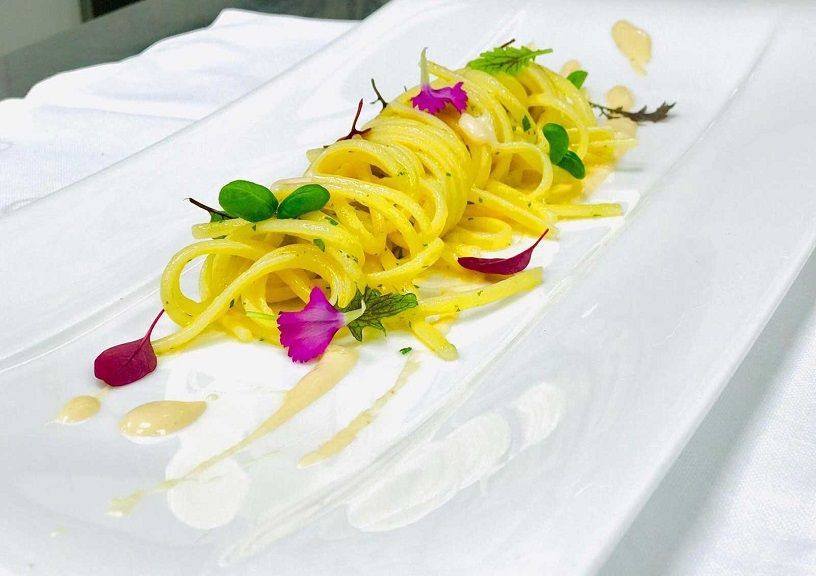
“There is nothing more beautiful for a chef than looking out from a balcony overlooking the sea and taking inspiration from it. In the view from the Pink Palace, you can find the flavours and colours of our traditions, like a sort of palette of shades that I try to reproduce in my dishes. Cooking is enthusiasm for me – an ongoing challenge with ingredients. That’s why when I discover a new one, like the sea urchins, I can at least experiment and create a new dish with it, which excites me first and then my guests.”
Ingredients
- 360 gr. linguine
- 80 gr. sea urchin pulp
- Lemon Peel
- 60 gr. shelled sea snails
- 4 auburn tomatoes
- 1 bunch basil
- 1 garlic clove
- 50 gr. extra virgin olive oil
Instructions
First, put the chopped tomatoes in a blender and blend for about one minute. Sift the whole mixture, obtaining the tomato water.
In a pan, fry the garlic and oil, then add the tomato water and snails. Let them become a sauce.
Boil water and cook the linguine until al dente. Drain well, then stir in the tomato water sauce for a few seconds. Remove from heat and add the sea urchins, lemon peel, and basil.
Yellow Tomato Risotto, Burrata, and Lovage
Fabio Abbattista, Chef of L’Albereta in Franciacorta
Ingredients
Serves: 1
For the Yellow Tomato Sauce
- 500 gr. Datterino cherry tomatoes
- 40 ml. extra virgin olive oil
- 1 white onion
- 1 garlic clove
- 6 basil leaves
- Salt
Cut the onion into julienne strips. Stew it in the pan with the oil and garlic. Incorporate the cherry tomatoes, basil, and salt, and cook slowly for about 30 minutes on medium heat.
Remove the basil leaves and garlic. Switch to the Thermomix and then filter through a chinois.
For the Risotto
- 80 gr. Carnaroli rice
- 500 ml. vegetable broth
- 30 ml. white wine
- Yellow cherry tomato sauce
- 100 g. parmesan cheese (aged 24 months)
- 40 g. butter
- 20 ml. extra virgin olive oil
- Salt and white pepper, to taste
- Lovage leaves
Toast the rice with a pat of butter. Sprinkle with the white wine and blend. Add the salt and then the boiling broth.
Incorporate the yellow cherry tomato sauce and cook for about 12 minutes on medium heat. Stir the risotto with extra virgin olive oil, parmesan, pepper, and finely chopped lovage.
For the Burrata Cream
- A heart of burrata
- Extra virgin olive oil
- Salt, to taste
Emulsify everything in a mixer until it forms a smooth and homogenous cream.
Spread the risotto on the plate. Place the burrata cream on top.
Cheese and Pepper Paccheri Pasta With Osso Buco
Chef Alessandro Buffolino, Acanto Restaurant at Hotel Principe di Savoia in Milan
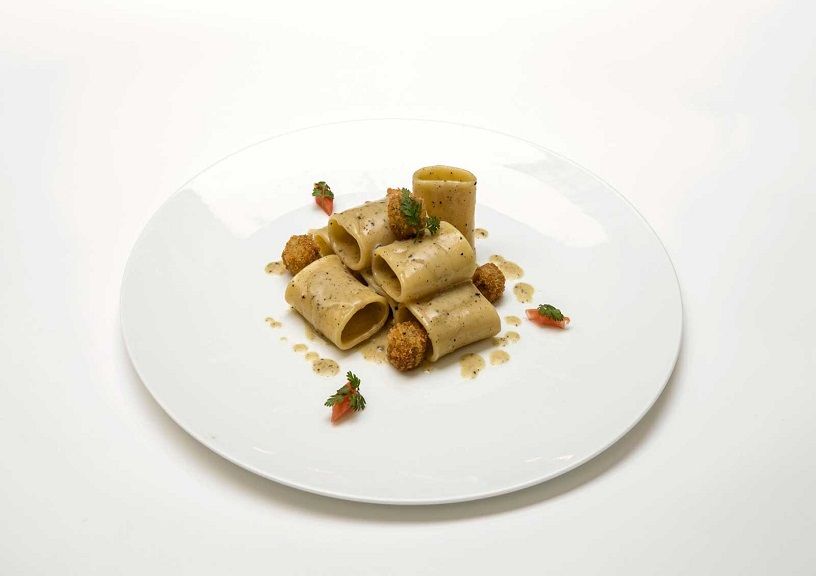
“It’s a typical Italian dish that mixes together two important culinary traditions: the Roman and Milanese.”
Ingredients
Serves: 4 people
- 350 gr. paccheri pasta De Cecco No. 325
- 100 gr. DOP Pecorino Romano cheese
- 50 gr. Parmigiano-Reggiano cheese
- 40 gr. pasta cooking water
- 1 tomato
- 100 gr. broth
- 1 osso buco
- 1 carrot
- 1 celery stalk
- 1 onion
- 1 aromatic bunch (mix of sage, thyme, and rosemary)
- 10 gr. black pepper grains
- 10 cl. white wine
- 500 gr. panko breadcrumbs
- Chervil
- 1 orange for zest
- 1 lemon for zest
- Herbs to taste
Instructions:
Lightly flour the osso buco and sear it in a pan.
Brown the carrots, tomatoes, celery and onions. Add the osso buco and the aromatic bunch, then pour in the broth until it is completely immersed. Cook over moderate heat for a couple of hours. Once cooked, let it cool down.
Mix together breadcrumbs, thyme, and orange and lemon zest.
Cut the osso buco into cubes and coat it in the breadcrumb mixture.
Boil water and cook pasta. While the pasta is cooking, press the black pepper grains in a mortar and warm it in a pan with a little olive oil. Once warmed, pour some white wine and add the broth.
With a Pacojet machine (a blender or mixer also works), mix the DOP Pecorino Romano cheese, Parmigiano-Reggiano cheese, and some pasta cooking water until it becomes a smooth cream.
Fry the osso buco cubes while the cream is assembling itself in the Pacojet.
In a saucepan, toss the paccheri with the sauce for about a minute on slow heat, then remove the pan from the flame and add the Pecorino and Parmigiano mix until it forms a smooth cream.
Put the pasta in the dish and garnish with small tomato cubes and the chervil.
Carpaccio Cipriani (Beef Carpaccio)
Roberto Gatto, Executive Chef of Cip’s Club at Belmond Hotel Cipriani in Venice

Inspired by his childhood at the kitchen table while his mother crafted baked goods, Italian chef Gatto focuses on simple and timeless dishes to be enjoyed with family and friends.
Ingredients
Serves: 4 people
- 1.75 lbs. sirloin or lean beef fillet
- 4 egg yolks
- 2 tsp. Colman’s mustard
- ½ lemon
- Salt as needed
- 2 cups olive oil
- ½ tbsp. Worcestershire sauce
- 1 tbsp. Tabasco sauce
Instructions
Cut the sirloin or lean beef fillet with a machine or knife and spread the slices on each serving plate. Put it in the fridge.
For the sauce, mix the egg yolks, mustard, lemon, Worcestershire sauce, and two or three drops of Tabasco (if too thick add some cold broth) in a bowl with a whisk.
Remove the carpaccio from the fridge and dip the sauce with a fork. Then, decorate the meat making the sauce drain from the tip of the fork while moving it.
(This story first appeared on travelandleisure.com)










